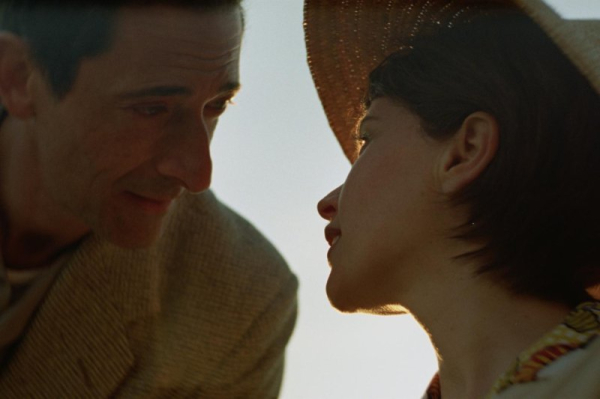Movie review: ‘The Brutalist’ an epic testament to work ethic

1 of 5 | Adrien Brody and Felicity Jones star in “The Brutalist,” in theaters Dec. 20. Photo courtesy of A24
At 3 hours, 35 minutes, The Brutalist, in theaters Friday, uses the historical epic genre to showcase the benefits and sacrifices of work and craft. Though centered around architecture, the themes are universal.
László Tóth (Adrien Brody) escapes Holocaust-era Budapest in the 1940s after being forcibly separated from wife, Erzsébet (Felicity Jones), and niece Zsófia (Raffey Cassidy). Erzsébet writes letters to László until she can join him. Advertisement
An acclaimed architect in Hungary, László gets work with his cousin, Attila (Alessandro Nivola). Designing a library for Harry Van Buren’s (Joe Alywn) father, Harrison (Guy Pearce), leads Lászlóto a major project that dominates the bulk of his life in the United States.
Whether designing furniture, a private library or the massive Van Buren Center, László approaches every project with a commitment to excellence. Good work begets more opportunities, proving there are no small projects. Advertisement
The Van Buren Center requires more collaboration and supervision, which brings with it setbacks that require compromise. Ultimately, Harrison makes the decisions because he controls the money, no matter how much he respects László as an artist.
The film showcases what is great about László’s designs. His library shelves unfold from the walls and his plans for the Van Buren Center are visionary in model form long before they are completed.
The Brutalist also shows the hardships independent businessmen face. László got Atilla more money for the library project, but is blamed when the client reneges on paying, something to which any freelancer can relate.
That specific setback foreshadows the sorts of issues with which László will have to deal on a grander scale in his larger projects.
The film also is honest that work is not enough for a complete life, no matter how great the masterpiece. László needs his family, a community and safety.
László remains loyal to Gordon (Isaach De Bankolé), whom he met in a food bank line upon his arrival in the United States. He pays his success forward by hiring Gordon on his projects, exemplifying yet another positive aspect of work ethic. Advertisement
Anti-Semitism is an aspect of the United States of the ’40s through ’60s that The Brutalist covers. Director Brady Corbet, who wrote the script with Mona Fastvold, avoids obvious depictions of prejudice.
Instead, The Brutalist depicts anti-Semitism in its true subtle, insidious forms. It simmers throughout László’s interactions so that it wears on him by the film’s second half.
Sexual violence also is characteristic of the times. Corbet and Fastvold handle it without being graphic, but it is clear what the Tóths face.
The movie is filmed in 70mm, and screenings in this format showcase how glorious the period piece can look when using classic cinematic techniques. Though it will screen in modern digital theaters, too, the opportunity to see it in 70mm is worth seeking.
The image is bright and sharp. Lest viewers take it for granted, montages incorporate stock footage (and even one VHS sequence in a 1980-set epilogue), to ensure the 70mm stands out when the film returns to the newly filmed footage.
Don’t let the specificity of the subject matter or its length be a deterrent to seeing The Brutalist. The film showcases the human experience as much as historical epics like Dances with Wolves or The Pianist, which also features Brody. Advertisement
Fred Topel, who attended film school at Ithaca College, is a UPI entertainment writer based in Los Angeles. He has been a professional film critic since 1999, a Rotten Tomatoes critic since 2001, and a member of the Television Critics Association since 2012 and the Critics Choice Association since 2023. Read more of his work in Entertainment.
